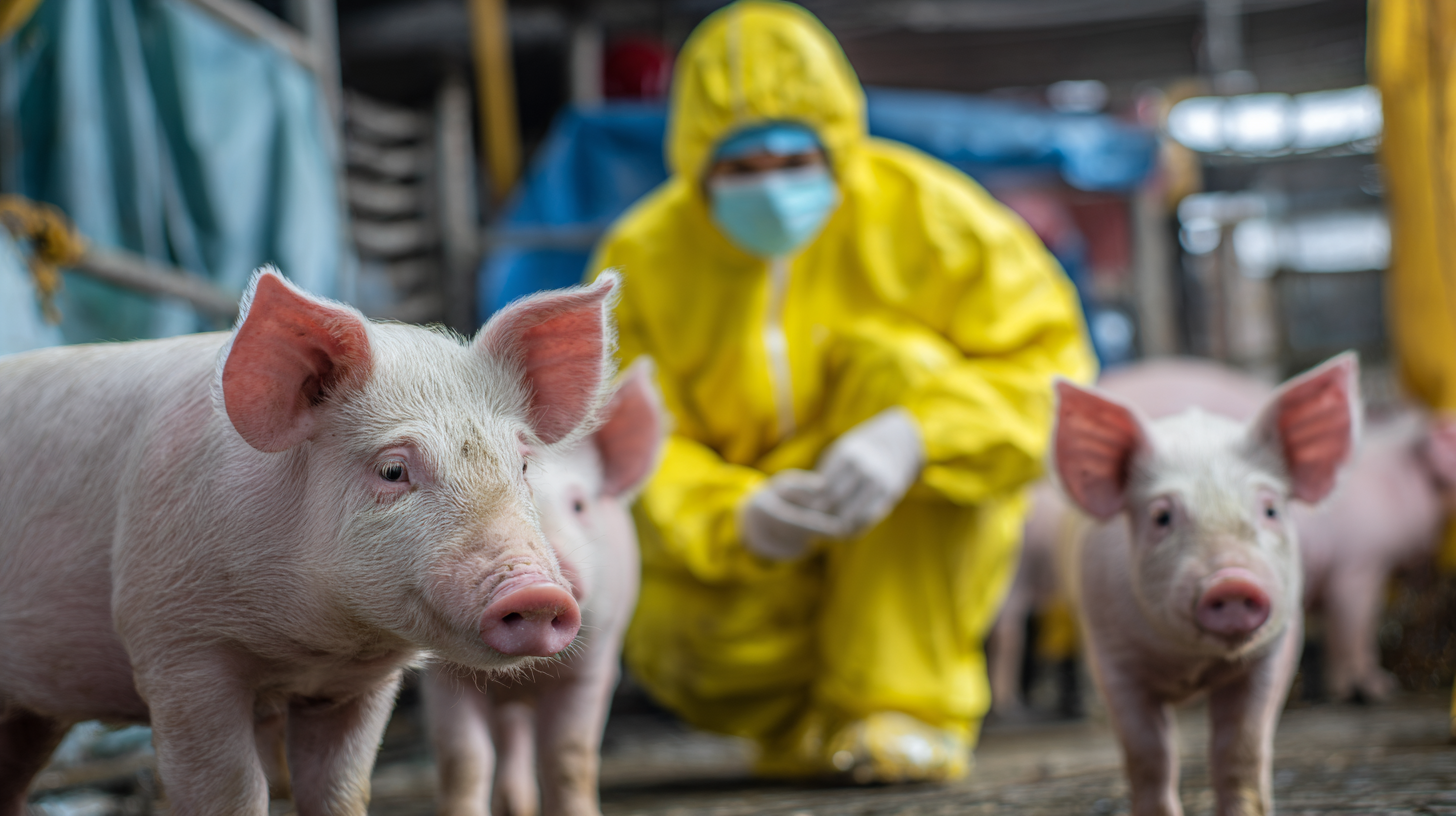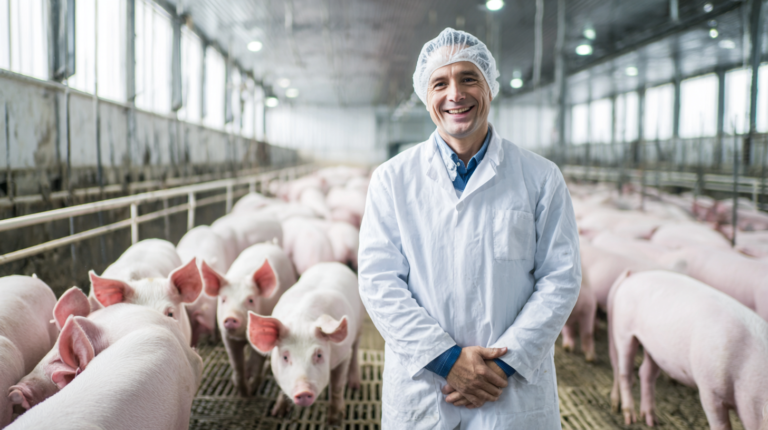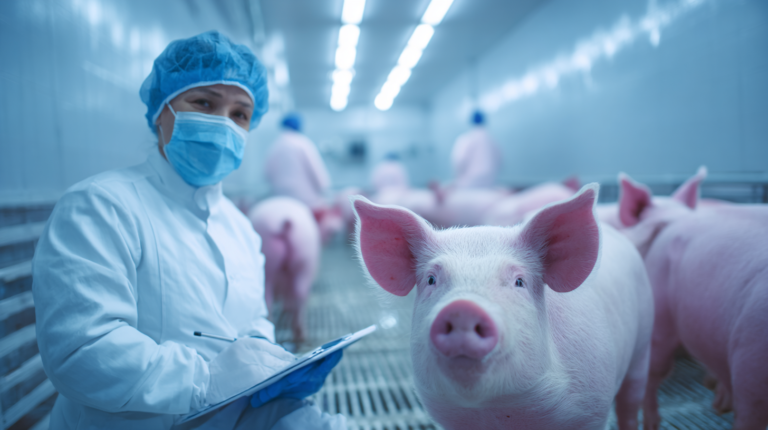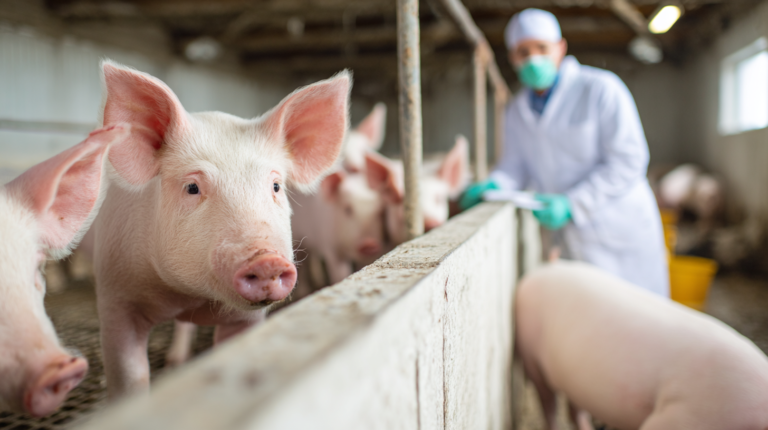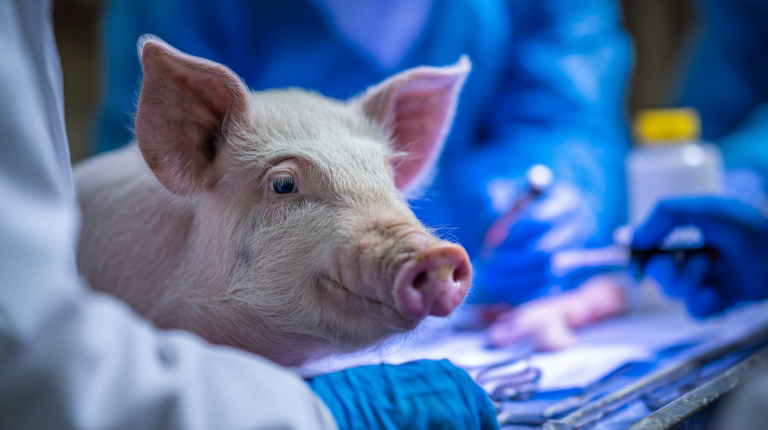Learn how to prevent and control Foot and Mouth Disease in pigs with these 4 essential veterinary-approved tips. Protect your swine from this highly contagious viral infection.
Table of Contents
Foot and Mouth Disease in pigs represents one of the most economically devastating and highly contagious viral infections affecting livestock worldwide. This acute vesicular disease doesn’t just impact commercial pig farming operations—it can also affect miniature pigs, potbellied pigs, and other swine species kept as pets or in small-scale farming environments. Understanding the prevention, identification, and control measures for this disease is crucial for anyone involved in pig care, whether you’re a commercial producer, hobby farmer, or pet pig owner.

The economic impact of foot and mouth disease outbreaks extends far beyond individual farms, affecting entire regions and international trade relationships. According to the Food and Agriculture Organization (FAO), a single outbreak can result in millions of dollars in losses through livestock mortality, culling programs, trade restrictions, and vaccination campaigns. For pig owners, the emotional toll of losing beloved animals to this preventable disease adds another layer of concern that makes understanding proper prevention protocols absolutely essential.
This comprehensive guide will equip you with the knowledge and practical strategies needed to protect your pigs from foot and mouth disease while maintaining optimal health and productivity in your herd or pet pig household.
Understanding Foot and Mouth Disease:
| Disease Stage | Clinical Signs | Location | Severity | Timeline |
|---|---|---|---|---|
| Early Stage | Fever, lethargy, loss of appetite | Systemic | Mild | 1-3 days post-infection |
| Vesicular Stage | Small fluid-filled blisters | Mouth, tongue, lips | Moderate | 2-4 days post-infection |
| Vesicular Stage | Blisters on feet and coronary band | Hooves, interdigital space | Moderate | 2-5 days post-infection |
| Rupture Stage | Vesicles rupture, creating painful erosions | Mouth and feet | Severe | 3-6 days post-infection |
| Secondary Signs | Excessive salivation, drooling | Oral cavity | Moderate | Throughout infection |
| Secondary Signs | Lameness, reluctance to move | Locomotion | Severe | 3-7 days post-infection |
| Secondary Signs | Difficulty eating and drinking | Feeding behavior | Severe | Throughout infection |
| Recovery Stage | Healing of lesions, scab formation | Previously affected areas | Mild | 7-14 days post-infection |
Foot and Mouth Disease (FMD) is caused by a highly contagious virus belonging to the genus Aphthovirus within the family Picornaviridae. Seven distinct serotypes of the virus exist (A, O, C, Asia 1, SAT 1, SAT 2, and SAT 3), with each requiring specific vaccination protocols for effective prevention. The virus primarily affects cloven-hoofed animals, including pigs, cattle, sheep, goats, and various wild species.
What makes foot and mouth disease particularly concerning for pig owners is the virus’s remarkable ability to survive in the environment. The pathogen can remain viable in organic matter for weeks, on contaminated surfaces for days, and can spread through airborne particles over considerable distances under favorable weather conditions. Research published in the Journal of Veterinary Medicine indicates that the virus can travel up to 60 kilometers through air currents, making geographical isolation alone insufficient for prevention.
The economic implications of foot and mouth disease in pigs are staggering. The 2001 outbreak in the United Kingdom resulted in the culling of over 6 million animals and cost the economy an estimated £8 billion. In developing countries where pig farming provides crucial protein sources and income for rural families, FMD outbreaks can devastate local communities and food security.
Dr. Sarah Mitchell, a veterinary epidemiologist at the International Livestock Research Institute, explains: “Foot and mouth disease represents a perfect storm of high contagiousness, economic impact, and animal welfare concerns. The virus’s ability to spread rapidly through direct contact, contaminated materials, and even airborne transmission makes it one of the most challenging diseases to control in pig populations.”
Understanding the virus’s characteristics helps explain why prevention must be multifaceted and rigorously implemented. The incubation period typically ranges from 2 to 8 days, during which infected animals may not show clinical signs but can still transmit the virus to others. This silent transmission period makes early detection and preventive measures absolutely critical for successful disease control.
Clinical Signs and Symptoms: Recognizing FMD in Your Pigs
Early recognition of foot and mouth disease symptoms in pigs can mean the difference between containing an outbreak and facing devastating losses. The clinical presentation often begins subtly, making vigilant observation essential for pig owners and caretakers.
The hallmark symptoms of foot and mouth disease in pigs include the formation of vesicles (fluid-filled blisters) on the feet, snout, tongue, and lips. These vesicles typically appear 24 to 48 hours after the initial fever spike and can rupture within 24 hours, leaving painful erosions that significantly impact the animal’s ability to eat, drink, and move comfortably.
Fever is often the first clinical sign, with affected pigs showing temperatures ranging from 104°F to 106°F (40°C to 41°C). This pyrexic response is typically accompanied by lethargy, loss of appetite, and reluctance to move. Observant pig owners may notice their animals standing with their backs arched, shifting weight frequently between feet, or showing obvious signs of discomfort when walking.
Oral lesions present particular challenges for affected pigs. Vesicles on the tongue, dental pad, and lips can make eating and drinking extremely painful, leading to rapid weight loss and dehydration. The characteristic “smacking” sound that pigs make when oral lesions are present often serves as an early auditory indicator of the disease.
Foot lesions typically develop around the coronary band (the junction between the hoof and skin) and between the toes. These lesions can become secondarily infected with bacteria, leading to lameness, abscess formation, and potential long-term hoof problems. In severe cases, the outer hoof wall may separate completely, a condition known as “hoof sloughing.”
This visual guide illustrates the typical progression of lesions, helping pig owners differentiate between FMD and other vesicular diseases such as swine vesicular disease or vesicular exanthema. The distinctive distribution pattern and rapid progression of lesions are key diagnostic features that warrant immediate veterinary attention.
Secondary complications can develop when foot and mouth disease weakens the pig’s immune system, making animals susceptible to bacterial infections, pneumonia, and other opportunistic pathogens. Young piglets are particularly vulnerable, with mortality rates reaching 20-50% in some outbreaks due to myocarditis (heart muscle inflammation) caused by the virus.
Essential Control Tip #1: Implementing Strict Biosecurity Measures
The foundation of foot and mouth disease prevention lies in establishing and maintaining comprehensive biosecurity protocols that address all potential pathways of viral introduction and spread. These measures must be implemented consistently and adapted to the specific circumstances of each pig-keeping operation, whether commercial or residential.
Vehicle and equipment disinfection protocols form the first line of defense against FMD introduction. All vehicles entering pig-keeping premises should pass through disinfection stations containing approved virucidal agents such as sodium hydroxide (2% solution), sodium carbonate (4% solution), or citric acid (0.2% solution). The contact time must be sufficient to ensure viral inactivation—typically 10 minutes for most approved disinfectants.
Personnel biosecurity measures require careful attention to clothing, footwear, and personal hygiene practices. Anyone entering pig areas should wear facility-specific clothing and footwear that has been disinfected or laundered on-site. The implementation of shower-in/shower-out procedures may be necessary for high-risk operations or during periods of heightened disease surveillance.
Feed and water security protocols must address potential viral contamination through these essential resources. Feed ingredients should be sourced from approved suppliers with documented biosecurity practices, and water sources should be tested regularly for viral contamination. The virus can survive in water for extended periods, particularly in cool, neutral pH conditions.
Visitor restriction policies should clearly define who may enter pig areas and under what circumstances. Essential visitors such as veterinarians, feed delivery personnel, and maintenance workers should follow strict protocols including health declarations, equipment disinfection, and adherence to facility-specific biosecurity measures.
Wildlife and pest control measures address the potential for viral transmission through wild animals and arthropod vectors. While pigs are the primary amplifying hosts for FMD, wild boar and other susceptible species can maintain the virus in the environment. Effective fencing, habitat modification, and integrated pest management strategies help reduce these risks.
Record-keeping and traceability systems support biosecurity efforts by documenting all movements, visitors, and potential exposure events. These records prove invaluable during disease investigations and help demonstrate compliance with regulatory requirements.
Essential Control Tip #2: Vaccination Strategies and Protocols
Strategic vaccination programs represent one of the most effective tools for preventing foot and mouth disease in pig populations, though implementation requires careful planning and coordination with veterinary authorities. The success of vaccination programs depends on understanding viral serotypes, vaccine selection, timing, and integration with overall disease prevention strategies.
The choice of vaccine must match the prevalent viral serotypes in the region or those most likely to be introduced through trade or travel. Monovalent vaccines protect against single serotypes, while polyvalent vaccines provide broader protection against multiple serotypes. The decision between these options depends on local epidemiological conditions and regulatory requirements.
Vaccination timing plays a crucial role in program effectiveness. Primary vaccination typically begins at 8-12 weeks of age, followed by booster vaccinations at 3-4 month intervals. Breeding animals require special consideration, with vaccination schedules designed to ensure maternal antibody transfer to offspring while maintaining protective immunity throughout the breeding cycle.
Emergency vaccination protocols may be implemented during outbreak situations to create protective barriers around affected areas. These ring vaccination strategies require rapid deployment of vaccine stocks and careful coordination with animal health authorities to ensure proper coverage and documentation.
Vaccine storage and handling procedures must maintain cold chain integrity to preserve vaccine efficacy. Most FMD vaccines require refrigeration at 2-8°C and have limited shelf lives that must be carefully monitored. Proper vaccine reconstitution and administration techniques ensure optimal immune responses in vaccinated animals.
Dr. James Rodriguez, a veterinary immunologist specializing in livestock vaccines, notes: “The key to successful FMD vaccination programs lies in understanding that vaccines are tools within a comprehensive prevention strategy, not standalone solutions. Regular serological monitoring helps ensure that vaccination programs are achieving their intended protective effects.”
Monitoring vaccine efficacy through serological testing provides objective measures of program success. Regular blood sampling and antibody level testing help identify animals requiring booster vaccinations and assess overall herd immunity levels. This data supports evidence-based decisions about vaccination frequency and vaccine selection.
Essential Control Tip #3: Early Detection and Rapid Response Systems
The development of robust early detection systems represents a critical component of foot and mouth disease control, as rapid identification and response can significantly limit the scope and impact of outbreaks. These systems must integrate clinical surveillance, laboratory diagnostics, and communication networks to ensure timely intervention.
Clinical surveillance protocols should establish clear procedures for recognizing and reporting suspected FMD cases. This includes training pig caretakers to identify early clinical signs, establishing communication channels with veterinary authorities, and implementing standardized reporting forms that capture essential epidemiological information.
Laboratory diagnostic capabilities must be readily accessible and capable of providing rapid, accurate results. Modern diagnostic approaches include enzyme-linked immunosorbent assays (ELISA), reverse transcription polymerase chain reaction (RT-PCR), and virus isolation techniques. The availability of field-deployable diagnostic kits can significantly reduce the time between sample collection and results.
Sample collection and submission procedures require careful attention to maintain sample integrity and ensure accurate test results. Vesicular fluid, epithelial tissue, and serum samples must be collected using appropriate techniques and transported under proper conditions to maintain viral viability and antigen integrity.
Communication networks facilitate rapid information sharing between pig owners, veterinarians, and regulatory authorities. These networks may include phone trees, electronic reporting systems, and social media platforms that enable real-time information sharing about suspected cases and control measures.
Response team activation procedures should clearly define roles and responsibilities for various stakeholders during suspected or confirmed FMD cases. This includes veterinary investigation teams, laboratory personnel, regulatory officials, and support staff who may be involved in containment and control efforts.
Movement restrictions and quarantine protocols form essential components of rapid response systems. These measures may include stopping all pig movements from affected premises, establishing surveillance zones around suspected cases, and implementing traceability systems to identify potentially exposed animals.
Essential Control Tip #4: Environmental Management and Decontamination
Effective environmental management and decontamination protocols are essential for eliminating foot and mouth disease virus from contaminated premises and preventing reintroduction of the pathogen. These measures must address all potential viral reservoirs and transmission pathways within and around pig-keeping facilities.
Facility design considerations significantly impact the effectiveness of decontamination efforts. Hard surfaces that can be easily cleaned and disinfected, adequate drainage systems, and proper ventilation all contribute to successful environmental management. Facilities with porous surfaces, poor drainage, or inadequate ventilation present greater challenges for viral elimination.
Cleaning and disinfection protocols must follow systematic approaches that ensure complete coverage of all potentially contaminated surfaces. This includes a thorough cleaning phase to remove organic matter, followed by application of appropriate disinfectants at proper concentrations and contact times. The presence of organic matter can significantly reduce disinfectant efficacy, making the cleaning phase critical for success.
Disinfectant selection should be based on proven efficacy against FMD virus under the specific conditions present at the facility. Common effective disinfectants include sodium hydroxide, sodium carbonate, acetic acid, and various commercial formulations specifically labeled for FMD virus control. The choice of disinfectant may depend on factors such as temperature, pH, and the presence of organic matter.
Waste management protocols address the proper disposal of potentially contaminated materials, including bedding, feed, manure, and carcasses. These materials may harbor viable virus for extended periods and require proper treatment before disposal. Composting, burial, or incineration may be appropriate depending on local regulations and facility capabilities.
Air quality management becomes particularly important in enclosed facilities where airborne viral particles may persist. Proper ventilation systems, air filtration, and environmental monitoring help reduce the risk of airborne transmission and accelerate viral clearance from facility air spaces.
Monitoring and verification procedures ensure that decontamination efforts have been successful. This may include environmental sampling for viral detection, indicator organism testing, or other measures that provide objective evidence of successful decontamination.
Long-term Prevention and Surveillance Strategies
| Control Measure | Implementation Details | Priority Level | Effectiveness | Cost Impact |
|---|---|---|---|---|
| Quarantine & Isolation |
|
Critical | 95% | Low |
| Disinfection Protocols |
|
Critical | 90% | Medium |
| Personnel Biosecurity |
|
Critical | 85% | Low |
| Vaccination Programs |
|
High | 80% | High |
| Vehicle Disinfection |
|
High | 75% | Medium |
| Environmental Management |
|
High | 70% | Medium |
| Surveillance Systems |
|
Important | 85% | Medium |
| Feed & Water Security |
|
Important | 65% | Low |
Sustainable foot and mouth disease prevention requires long-term commitment to surveillance, preparedness, and continuous improvement of control measures. These strategies must evolve with changing risk factors, technological advances, and lessons learned from outbreak experiences.
Regional surveillance programs provide early warning systems for FMD threats through coordinated monitoring of animal health status, viral circulation patterns, and risk factors. These programs often involve collaboration between government agencies, veterinary institutions, and livestock organizations to share information and resources.
Risk assessment frameworks help pig owners and authorities prioritize prevention efforts based on the likelihood and potential impact of FMD introduction. Factors considered in risk assessments include geographical location, trade patterns, wildlife populations, and historical outbreak data.
Preparedness planning involves developing detailed response protocols, maintaining emergency supplies, and conducting regular training exercises. These plans should address various outbreak scenarios and clearly define roles and responsibilities for all stakeholders involved in disease control efforts.
International cooperation facilitates information sharing about FMD threats, best practices, and technological advances. Organizations such as the World Organisation for Animal Health (OIE) and the Food and Agriculture Organization (FAO) provide frameworks for international collaboration and standardized approaches to disease control.
Research and development efforts continue to improve available tools for FMD prevention and control. This includes development of new vaccines, diagnostic tests, and treatment approaches that may enhance the effectiveness of control programs.
Economic Impact and Trade Considerations
The economic implications of foot and mouth disease extend far beyond immediate animal losses, affecting international trade, market access, and regional economic stability. Understanding these broader impacts helps justify investments in prevention and control measures while highlighting the importance of maintaining FMD-free status.
Trade restrictions imposed during FMD outbreaks can devastate export markets and create lasting economic impacts. Countries importing pork and pork products typically impose immediate bans on imports from affected regions, often lasting months or years after outbreak resolution. These restrictions can result in lost market share that may never be fully recovered.
The cost of control measures during outbreaks includes expenses for surveillance, testing, movement restrictions, culling, and compensation programs. The 2001 FMD outbreak in the United Kingdom resulted in direct costs exceeding £3 billion, with additional indirect costs to related industries including tourism, transportation, and feed manufacturing.
Insurance and risk management strategies help pig producers protect against FMD-related losses. Specialized livestock insurance policies may cover animal losses, business interruption, and additional expenses associated with outbreak response. However, coverage limitations and exclusions make prevention the most cost-effective approach to managing FMD risks.
Market recovery following FMD outbreaks requires demonstrated freedom from the disease through extensive surveillance and testing programs. The timeline for market recovery depends on the effectiveness of control measures, international confidence in surveillance systems, and compliance with importing country requirements.
Regulatory Framework and Compliance Requirements
| Timeline Phase | Diagnostic Methods | Treatment Actions | Response Time | Expected Outcomes |
|---|---|---|---|---|
| Immediate Response (0-6 hours) |
Clinical examination
Symptom assessment
Digital photography
|
|
CRITICAL | Prevention of spread, initial containment |
| Rapid Testing (6-24 hours) |
Antigen detection tests
Sample collection
Field testing kits
|
|
URGENT | Preliminary diagnosis, enhanced containment |
| Laboratory Confirmation (1-3 days) |
RT-PCR testing
Virus isolation
Serological testing
|
|
HIGH | Definitive diagnosis, tailored response plan |
| Treatment Implementation (3-7 days) |
Progress monitoring
Antibody testing
Lesion assessment
|
|
HIGH | Disease control, symptom relief |
| Recovery Monitoring (1-2 weeks) |
Healing assessment
Appetite monitoring
Mobility evaluation
|
|
MODERATE | Clinical improvement, lesion healing |
| Follow-up Testing (2-4 weeks) |
Virus clearance testing
Antibody monitoring
Carrier status assessment
|
|
ROUTINE | Disease clearance confirmation |
| Long-term Surveillance (1-6 months) |
Periodic blood sampling
Clinical examinations
Herd health monitoring
|
|
ROUTINE | Complete recovery, trade restoration |
| Prevention Maintenance (Ongoing) |
Regular health checks
Vaccination titer monitoring
Risk assessment updates
|
|
SCHEDULED | Disease prevention, herd protection |
The regulatory landscape surrounding foot and mouth disease control varies significantly between countries and regions, but generally includes reporting requirements, movement restrictions, and prescribed control measures. Understanding these requirements is essential for compliance and effective disease prevention.
Reporting obligations typically require immediate notification of suspected FMD cases to veterinary authorities. Failure to report suspected cases can result in serious penalties and may compromise control efforts. Many jurisdictions have established hotlines and electronic reporting systems to facilitate rapid case reporting.
Movement restrictions may be imposed proactively in high-risk areas or reactively following suspected or confirmed cases. These restrictions can affect animal movements, equipment transport, and personnel access to affected areas. Understanding the legal framework for movement restrictions helps pig owners prepare for potential restrictions and comply with requirements.
Compensation programs may be available for animals culled during FMD control efforts, though eligibility requirements and payment levels vary significantly. These programs help offset the financial impact of control measures while encouraging cooperation with authorities.
International standards developed by organizations such as the OIE provide frameworks for FMD prevention and control that facilitate international trade. Compliance with these standards supports market access and demonstrates commitment to disease prevention.
Emergency Response and Crisis Management
Effective emergency response to foot and mouth disease outbreaks requires pre-established protocols, trained personnel, and rapid decision-making capabilities. The speed and effectiveness of initial response efforts often determine the ultimate scope and impact of outbreaks.
Incident command systems provide organizational frameworks for coordinating multi-agency responses to FMD outbreaks. These systems clearly define roles and responsibilities, establish communication protocols, and facilitate efficient resource allocation during crisis situations.
Resource mobilization capabilities must be sufficient to support extensive surveillance, testing, and control operations. This includes personnel, equipment, supplies, and funding mechanisms that can be rapidly deployed during outbreak situations.
Communication strategies during outbreaks must balance transparency with the need to prevent panic and misinformation. Clear, accurate, and timely communication helps maintain public confidence while supporting compliance with control measures.
Recovery planning begins during the acute phase of outbreak response and focuses on restoring normal operations while preventing reintroduction of the virus. This includes environmental decontamination, restocking protocols, and market recovery strategies.
Frequently Asked Questions About Foot and Mouth Disease in Pigs
The FMD virus can survive for varying periods depending on environmental conditions. In cool, moist conditions with neutral pH, the virus may remain viable for several weeks in organic matter. On dry surfaces, survival time is generally shorter, typically days to weeks. Temperature, humidity, and UV exposure significantly affect viral survival rates.
Foot and mouth disease rarely affects humans and is not considered a significant public health concern. When human infections do occur, they are typically mild and resolve without treatment. The virus that causes FMD in animals is different from the hand, foot, and mouth disease that affects children.
Immediately isolate the affected animal and contact your veterinarian and local animal health authorities. Do not move any animals on or off your property, and implement strict biosecurity measures to prevent spread. Early reporting is crucial for effective control and may be legally required in your area.
FMD vaccines can be highly effective when properly selected, administered, and maintained. However, effectiveness depends on matching vaccine serotypes to circulating virus strains, proper storage and handling, and appropriate vaccination schedules. Regular monitoring of antibody levels helps ensure continued protection.
Effective disinfectants include sodium hydroxide (2% solution), sodium carbonate (4% solution), citric acid (0.2% solution), and various commercial products specifically labeled for FMD virus control. The key is ensuring adequate contact time and proper concentration while removing organic matter first.
Movement restrictions vary based on outbreak circumstances and regulatory requirements, but typically last several weeks to months. Restrictions are gradually lifted as surveillance confirms absence of viral circulation and control measures prove effective. The process may take 3-6 months or longer for complete lifting of restrictions.
For more expert pet care tips and product recommendations, visit BlithePet.com — your trusted source for pet wellness.
Conclusion
Foot and mouth disease in pigs represents a serious threat that requires comprehensive prevention strategies, early detection systems, and rapid response capabilities. The four essential control tips outlined in this guide—strict biosecurity measures, strategic vaccination programs, early detection systems, and environmental management—form the foundation of effective FMD prevention.
The economic and animal welfare impacts of foot and mouth disease make prevention efforts not just advisable but essential for anyone involved in pig care. By implementing these evidence-based strategies and maintaining vigilant surveillance, pig owners can significantly reduce the risk of FMD introduction and spread while protecting their animals and livelihoods.
Success in FMD control requires sustained commitment, regular evaluation of prevention measures, and adaptation to changing risk factors. The investment in prevention is invariably less costly than dealing with the consequences of an outbreak, making these control strategies both economically and ethically sound approaches to pig health management.
Remember that foot and mouth disease prevention is an ongoing process that requires vigilance, preparation, and collaboration with veterinary professionals and regulatory authorities. By staying informed about current threats and maintaining robust prevention protocols, pig owners can help protect their animals and contribute to broader disease control efforts.
Have a similar experience with your pet? Share it in the comments below!

